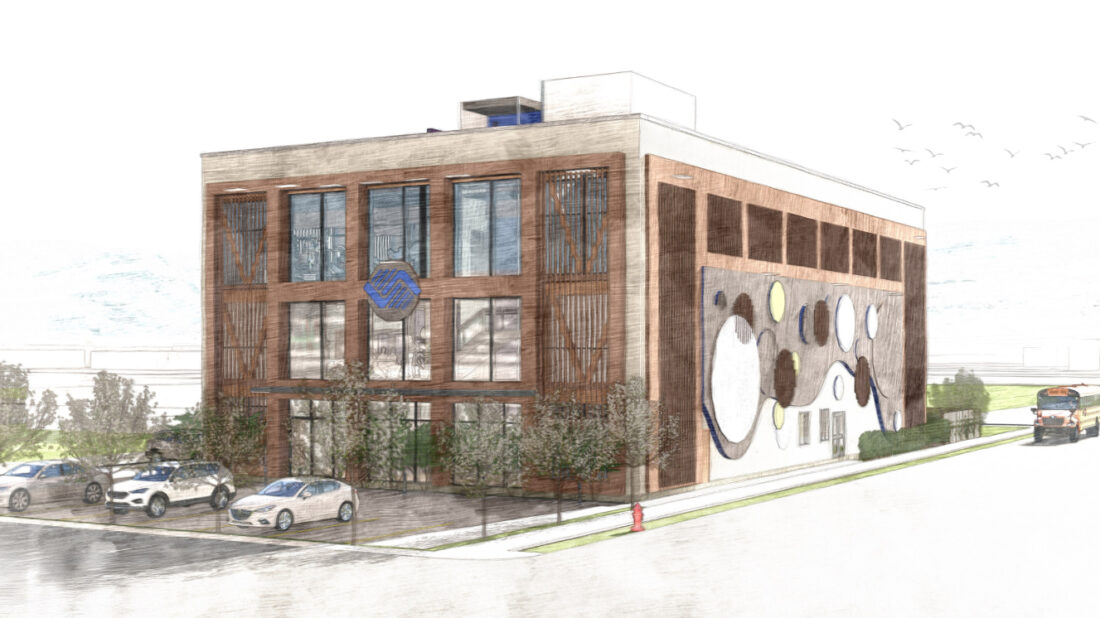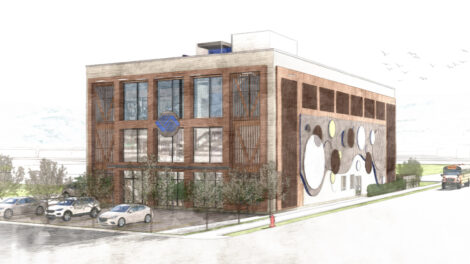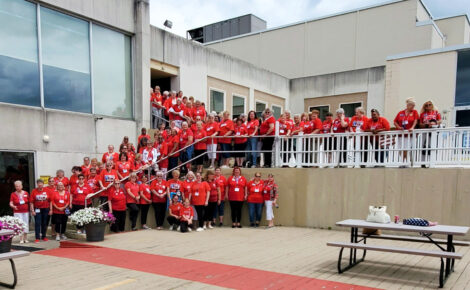Architecture students design ideas for net-zero youth center

PHOTO PROVIDED A rendering by Pennsylvania College of Technology architecture & sustainable design students shows what a net-zero energy Boys & Girls Clubs of America facility in Williamsport could look like. The students worked with Mayor Derek Slaughter to develop the design, which they showcased during the U.S. Department of Energy’s BuildingsNEXT challenge.
WILLIAMSPORT — A team of Pennsylvania College of Technology students recently completed the U.S. Department of Energy’s BuildingsNEXT challenge — and simultaneously provided the City of Williamsport a picture of what a net-zero energy youth facility in the city could look like.
The BuildingsNEXT Student Design Competition — formerly the Solar Decathlon — encourages college students to design high-performance buildings that improve quality of life through great affordability, resiliency and energy efficiency.
Students were encouraged to choose a project that could bring positive change to their communities. In the past, Penn College teams have completed design projects for local groups like Greater Lycoming Habitat for Humanity and Family Promise of Lycoming County.
“This year, we reached out to Mayor Derek Slaughter and asked: ‘Is there something that the city would like some input on – something the students could help you visualize?'” explained Dorothy J. Gerring, associate professor of architecture and the team’s adviser. Gerring is also the architecture department head.
The students’ collaboration with the city resulted in a design for a Boys & Girls Clubs of America facility meant to serve as an after-school, weekend and summer camp for school-age children. Their design includes a gymnasium, walking track, locker rooms, kitchen/cafeteria, education space, quiet learning area, gamers lounge and recording studio, as well as a pollinator garden.
The students’ design was based on Boys & Girls Clubs of America standards and information in the city’s Park Avenue Plan.
The students began working on the facility design in October — when the competition was still formatted as the “Solar Decathlon” — and met with Slaughter throughout the process.
“This project is a testament to the students’ dedication, creativity and vision,” the mayor said. “Their design aligns with our city’s commitment to creating sustainable, safe and inspiring spaces where young people can grow, thrive and lead.”
In May, the students joined 18 other collegiate teams in the Open Commercial Division to present their plans to a panel of industry experts. While originally a 10-part competition with semifinals and finals, the event transitioned in early 2025 to a “showcase” for any team that chose to present.
“This project would be Williamsport’s first net-zero building,” said Kayla A. Weinzierl, a Bachelor of Architecture student from Summerhill. “It is designed with the health, safety and the community at its core.”
In a net-zero energy building, 100% of energy demand is met by on-site renewable energy.
To achieve net zero, the students’ plans call for solar panels on the roof. A tight building envelope helps minimize energy demand from its heating, ventilation and air conditioning system.
The students chose a vertical geothermal heating system. Their design takes advantage of daylighting from the sun. On the building’s east and west sides, vertical louvres on the windows help to minimize glare and solar heat gain, while a green wall system — an exterior wall covered in plants — provides extra insulation and is a natural air filter. Horizontal window shading on the south side minimizes solar heat gain in summer and maximizes it in winter.
Their design also incorporates kinetic energy technology in fitness equipment and under the gymnasium floor. The technology uses movement to generate electricity.
The students selected building materials and furnishings that are Pennsylvania sourced and low in volatile organic compounds. The building’s structural system uses mass timber — a renewable resource that can be sourced locally and is a low-carbon alternative to concrete or steel. Pervious concrete also helps to reduce the facility’s impact.
The seven-member team was made up of architecture students Jordan K. Ace, of Franklin; Jazira Baez Mercedes, of Pittsburgh; Ciara E. Fey, of Hegins; Sandra M. Gallick, of Linden; and Kayla A. Weinzierl, of Summerhill. All but Gallick were second-year students. Gallick completed a Bachelor of Science in architecture & sustainable design in May. Baez Mercedes graduated in May with an associate degree in architecture. Ace, Fey and Weinzierl are pursuing Bachelor of Architecture degrees.
Team member Lindsay N. Repman, of Williamsport, is pursuing a Bachelor of Science in business administration; and John P. McAnally Jr., of Coopersburg, is seeking a Bachelor of Science in heating, ventilation & air conditioning engineering technology. Both are third-year students.
“They had a great experience working in an interdisciplinary team,” Gerring said. “They were challenged to really step up because a lot of the things were very new to them.”
The project allowed them to broaden their experience by working with electrical and structural engineers, as well as the city and Boys & Girls Clubs of America, and by diving deeper into topics like costing and marketing.
“The students were tenacious,” Gerring said.
To learn more about Penn College’s architecture majors, which include a Bachelor of Architecture, a Bachelor of Science in architecture & sustainable design, and an Associate of Applied Science in architecture, call 570-327-4520 or visit www.pct.edu/architecture.
For information about Penn College, a national leader in applied technology education, visit www.pct.edu, email admissions@pct.edu or call toll-free 800-367-9222.



